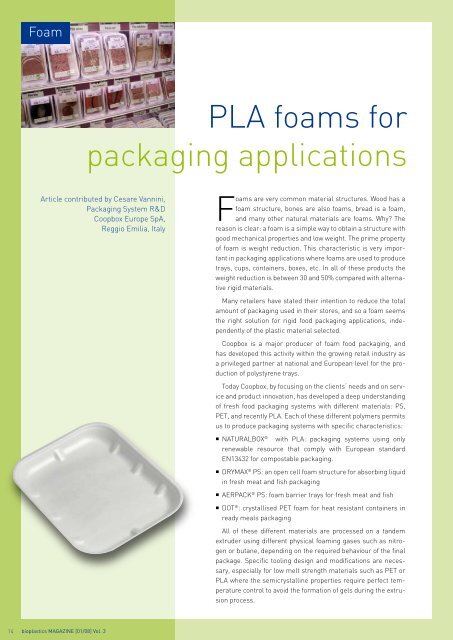01 | 2008
You also want an ePaper? Increase the reach of your titles
YUMPU automatically turns print PDFs into web optimized ePapers that Google loves.
Foam<br />
PLA foams for<br />
packaging applications<br />
Article contributed by Cesare Vannini,<br />
Packaging System R&D<br />
Coopbox Europe SpA,<br />
Reggio Emilia, Italy<br />
Foams are very common material structures. Wood has a<br />
foam structure, bones are also foams, bread is a foam,<br />
and many other natural materials are foams. Why? The<br />
reason is clear: a foam is a simple way to obtain a structure with<br />
good mechanical properties and low weight. The prime property<br />
of foam is weight reduction. This characteristic is very important<br />
in packaging applications where foams are used to produce<br />
trays, cups, containers, boxes, etc. In all of these products the<br />
weight reduction is between 30 and 50% compared with alternative<br />
rigid materials.<br />
Many retailers have stated their intention to reduce the total<br />
amount of packaging used in their stores, and so a foam seems<br />
the right solution for rigid food packaging applications, independently<br />
of the plastic material selected.<br />
Coopbox is a major producer of foam food packaging, and<br />
has developed this activity within the growing retail industry as<br />
a privileged partner at national and European level for the production<br />
of polystyrene trays.<br />
Today Coopbox, by focusing on the clients‘ needs and on service<br />
and product innovation, has developed a deep understanding<br />
of fresh food packaging systems with different materials: PS,<br />
PET, and recently PLA. Each of these different polymers permits<br />
us to produce packaging systems with specific characteristics:<br />
• NATURALBOX ® with PLA: packaging systems using only<br />
renewable resource that comply with European standard<br />
EN13432 for compostable packaging.<br />
• DRYMAX ® PS: an open cell foam structure for absorbing liquid<br />
in fresh meat and fish packaging<br />
• AERPACK ® PS: foam barrier trays for fresh meat and fish<br />
• DOT ® : crystallised PET foam for heat resistant containers in<br />
ready meals packaging<br />
All of these different materials are processed on a tandem<br />
extruder using different physical foaming gases such as nitrogen<br />
or butane, depending on the required behaviour of the final<br />
package. Specific tooling design and modifications are necessary,<br />
especially for low melt strength materials such as PET or<br />
PLA where the semicrystalline properties require perfect temperature<br />
control to avoid the formation of gels during the extrusion<br />
process.<br />
14 bioplastics MAGAZINE [<strong>01</strong>/08] Vol. 3


















